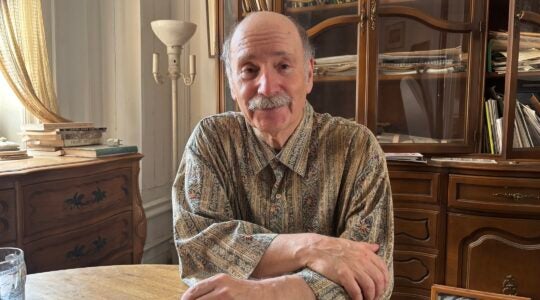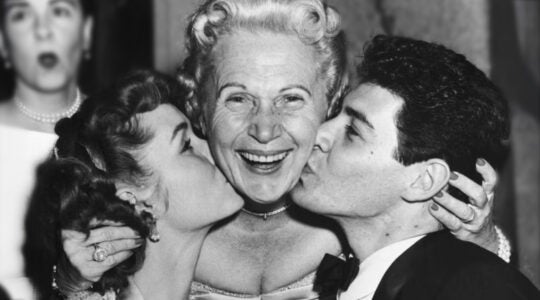Editor's Note: Click here for a news update on the 70th anniversary of the Hungarian Shoah.
In the Hungarian village of Csenger, by the banks of the river Smoosh, in the pages in a yizkor book, a dead man tells a tale. It is 1938. “Nine o’clock one Shabbos morning, people could be seen gathering together near the big market place,” looking up at the sky. “I was also standing there,” says the witness, “and in the middle of the crowd was a man with black glasses (probably binoculars) who kept passing them around in the crowd, and people kept looking upward … they saw two suns, one near the next.” Some say “the world is coming to an end.” The elders remembered this omen from 1914, before the terrible war.
In time, reports the yizkor book (compiled by survivors after the Shoah), “the crowd slowly left.” With the heavens in chaos, perhaps the world was indeed coming to an end, but it was still Shabbos in Csenger. In fact, that very day, March 12, 1938, the Nazis were marching into Austria, even as Hungarian Jews were looking at the sky. The yizkor book recalled how the Hungarian Jews were wondering, “the next day, whose turn would come?” It was their turn, almost six years later to the day.
This is the 70th anniversary of the Holocaust coming to Hungary; 1944, a year so deathly, so breathless, so elusive of existing language that a new word had to be invented — “genocide,” first coined in 1944 by writer and jurist Raphael Lemkin.
The Germans marched into Budapest on March 19, 1944, not to obliterate Hungary, a Hitler ally that itself declared war on the Soviet Union and the United States in 1941, but to fortify German defenses and ensure that Hungary wouldn’t surrender to Soviet troops on its border. In the Budapest Times last month, the prominent historian Krisztián Ungváry writes that, other than the Jews, “The population of Hungary was not subjugated. … Rather, the elite of the country got the opportunity to divide up the fortune of about 800,000 [Jews].” He adds that Adolf Eichmann, one of the overseers of the Final Solution, “himself was thrilled by his experiences here, observing that the Hungarians must surely be descended from the Huns since nowhere else had he seen so much brutality ‘in the course of solving the Jewish question.'”
Where the Wehrmacht went, the Holocaust followed. Almost immediately, 170 ghettos. In April, deportations. Within eight weeks, 437,000 were sent to Auschwitz. Through the Carpathians and Transylvanian mountains, villagers could see more than 140 smoking locomotives pulling thousands of boxcars; five trains unloaded in Auschwitz every day; eight trains every night, according to reports by the Jewish underground in Auschwitz who attempted to document every transport. By winter’s first frost nearly 565,000 Hungarian Jews were killed, including 40,000 who died in the Munkaszolgalat, Jewish forced-labor squads that pre-dated the occupation.
Pick a day, any day, May 28: A train arrives in the Auschwitz night, 48 to 50 boxcars long. The Jews are given blue tattoos, starting with A-5717; some get no numbers at all. On line for gassing, some Jews sense danger and run to the woods. They are shot like a flock of quail, in the beam of a spotlight.
Leon Trotsky had said that the 20th century was “the most disturbed century within the memory of humanity… a bad time to be born.” On June 25 a Jewish baby girl (tattoo A-7261) was born in Auschwitz. Empty strollers in rows of five are wheeled back to the boxcars.
Almost everything one had to know about 1944 was known. JTA, the New York-based Jewish news service, reported on July 4, 1944: “More than 1,715,000 Jews have been put to death in only two German ‘extermination camps’ [Auschwitz-Birkenau] within the last two years … 400,000 Hungarian Jews have been deported from their homeland since April 6 of this year under inhuman conditions. …. Those who did not die en route were delivered to the camps of Auschwitz… They were ‘selected’ or worked to death … ordered to strip for bathing. Then cyanide gas was said to have been released, causing death in three to five minutes.”
Everything was known, from the internal Auschwitz jargon (“selections”) to the charade of the showers. Everyone knew. “But not here,” Elie Wiesel tells us by telephone, “here” being the Hungary of his youth. If there was news about the camps, “How could we know? First of all, they confiscated our radios. We went to a Christian neighbor, while we still could, and heard the radio there. Imagine, if Roosevelt or Churchill had come on the BBC,” the only source of reliable news, “and said, ‘Jews, don’t go to the trains.’ My town, Sighet, was surrounded by the mountains. Some of us could have gone into the mountains. The Russians were only 30 kilometers away.”
Wiesel and others tell of “madmen,” hobos telling horror tales, but who listens to madmen or hobos? According to papers in Yad Vashem, even when “locked up in ghettos … the Jews still did not believe the Zionist young people who illegally travelled to the provinces, trying to encourage the people doomed to deportation and elimination, at least to escape.” Jews sometimes returned from the forced labor brigades with news from afar. As many as 15,000 Jewish refugees in Hungary from Poland, Austria and Slovakia had news of their own.
Wthout escape, almost everything important was reduced to illusion. As Julie Orringer writes of one character in “The Invisible Bridge,” a novel of the Hungarian experience, “The fact that he’d had a happy childhood in Konyar, had gone to school, learned to draw, gone to Paris, fallen in love, studied, worked, had a son,” everything was suddenly “stripped of context … consigned to impossibility … he was a particle of life, a speck of human dust, lost on the eastern edge of Europe.”
Hungary 1944 catapulted into eternal Jewish history such iconic names as Nobel Laureate Elie Wiesel; the Swedish diplomat Raoul Wallenberg, credited with rescuing thousands in Budapest; and Chana Senesh, a 23-year-old Hungarian Jew, a poet, who made aliyah but then returned, parachuting behind Nazi lines to join partisans attempting to help Hungarian Jews, before being almost immediately captured, tortured and killed later that year.
And then there was a Budapest Jewish official Rudolf Kastner, an ethical chameleon, all things to all people. Even his name: with Zionists, his name was Yisroel; with Hungarians, Rezso; with Germans, Rudolf, and as Rudolf he was best known. Whatever his name, he freed more Jews than any other person during the war, negotiating with Eichmann for a train that carried 1,685 Hungarian Jews to Switzerland. Years later, Senesh's mother testified in Israel that in 1944 she tried to get Kastner to intercede with Eichmann on behalf of her daughter, being held in a Budapest cell, but Kastner brushed her off.
After Eichmann was captured by the Israelis in 1960, he told Life magazine: “Dr. Rudolf Kastner [was] an ice-cold lawyer and a fanatical Zionist. He agreed to help keep the Jews from resisting deportation and even [helped] keep order in the collection camps if I would close my eyes and let a few hundred or a few thousand young Jews emigrate illegally to Palestine. … It was a good bargain.” In fact, Eichmann never let anyone go to Palestine, just Switzerland, but good enough. After the war, no longer obliged to Eichmann, Kastner nevertheless wrote affidavits to war crimes tribunals, asking leniency for several of Eichmann’s top Nazi associates in Hungary who oversaw the death of hundreds of thousands.
In 1957, Kastner was shot to death on a Tel Aviv sidewalk for being a collaborator, said his assassin.
“Ah, Rudolf Kastner,” says Wiesel. “A tragic case.” He came to Sighet, warned no one. “He was wrong and what was done to him was wrong.”
Of course, being warned and then knowing what to do were very different things. As the poet Wislawa Szynborska wrote, “You survived because you were first. You survived because you were last. Because alone. Because the others. … Because it was raining. Because it was sunny. Because a shadow fell. Luckily there was a forest. Luckily there were no trees. … Luckily a straw was floating on the water.”
All these years later, and as Faulkner said, the past isn’t dead, it isn’t even past. In New York, one can occasionally overhear elderly Jews whose mellifluous accents echo their childhoods in the Carpathian Mountains. Perhaps they tell their stories, what stories they choose to tell, to their children who themselves are now grandparents.
In the end, there are facts, but who remembers? There are stories, but few to tell them. "No writer,” says the yizkor book of Kisvarda, “has a rich enough imagination.” The highway signs still point to Munkacz, Csenger or Sighet. But “the Jewish visitor … meets only strangers.” Kisvarda and its lost world, says the yizkor book, “lives only in dreams.”
The New York Jewish Week brings you the stories behind the headlines, keeping you connected to Jewish life in New York. Help sustain the reporting you trust by donating today.




